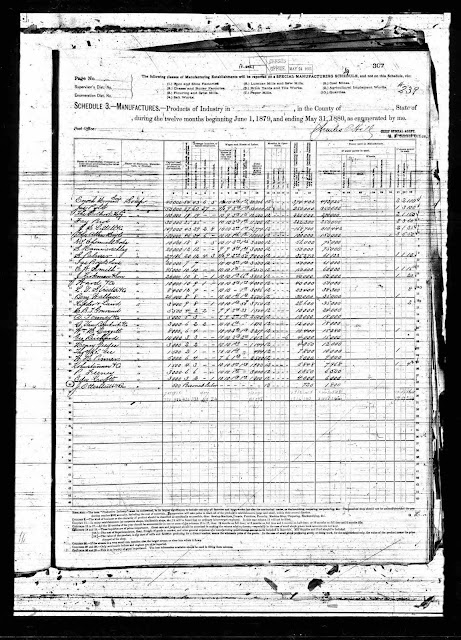Non-population to a genealogist suggests the various non-population census schedules that were created as part of the census enumeration every ten years between 1850 and 1880. These include agricultural, industrial, and manufacturing schedules which provide additional information about those who are enumerated in them. Digital images of these indexed schedules are available at Ancestry.
Since I have been sharing information about my soap-making ancestor, James Pyle, here is the 1880 U.S. census non-population industry schedule for the 28 soap makers of New York City.
And a closeup showing Jas. Pyle on line 2:
Since this is difficult to read, I have transcribed the headings and James Pyle's entry below.
(1) Name of Corporation, Company, or Individual producing to the value of $500 annually: Jas Pyle
(2) Name of Business, Manufacture, or Product: Soap
(3) Capital (real or personal) invested in the business: 50,000
(4) Greatest number of hands employed at any time during the year: 87
(5) Average number of hands employed / Males above 16 years: 60
(6) Average number of hands employed /Females above 15 years: 27
(7) Average number of hands employed / Children and youth: -
(8) Wages and Hours of Labor / May to November: 9 1/2
(9) Wages and Hours of Labor / November to May: 9
(10) Wages and Hours of Labor / Average day's wages for skilled mechanic: 3.50
(11) Wages and Hours of Labor / Average day's wages for ordinary laborer: 1.50
(12) Wages and Hours of Labor / Total amount paid in wages during the year: 50,000
(13) Months in Operation / On Full time: 12
(14) - (17) Months in Operation / On 3/4 time, 2/3 time, 1/2 time, and Idle: -
(18) Value of Material (including Mill Supplies and Fuel): 250,000
(19) Value of Product (including Jobbing and Repairing): 350,000
(20) - (26) Power Used in Manufacture / If Water Power is Used: -
(27) Power Used in Manufacture / If Steam Power is Used / Number of boilers: 1
(28) Power Used in Manufacture / If Steam Power is Used / Number of engines: 3
(29) Power Used in Manufacture / If Steam Power is Used / Horse-power: 100
Comparing his numbers with the others on the page, it appears that James Pyle was one of the larger soap makers in New York; he had the second largest number in column 19: Value of Product and he employed more people (and many more women) than any of the other soap makers (therefore paying the greatest amount paid in wages).
Perhaps one of the reasons my second great grandfather had so many employees was because some of them worked on his advertising campaigns. Following are the front and back of just two of his many advertising cards.







Elizabeth - I love this blog post. It cleanly illustrates the power (literally 100HP) of the non-population schedules available during this distinct period of time. It lathered up my curiosity about your ancestor and his context by just having a quick moment to soak in these details, that you took care in sharing. Well done as always. Great stories. Thank you. -Y
ReplyDeleteGlad you enjoyed the post. I enjoyed your puns! Thanks for reading and commenting.
Delete